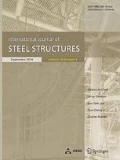Abstract
Design of protective structures requires multiple functions and reasonable safety criteria according to target structures. Hardening is one of the common concept to protect facilities and people. A general concept of blast pressure mitigation by metal foams was proposed. In this paper, a composite panel with aluminum foams and steel skins is introduced. Aluminum foams have low density and are attractive materials to mitigate high-speed pressure by blast loads due to high-energy absorption capabilities. A steel skin with high energy absorption capacity can be effectively used to resist penetration at front surface of the barrier and debris risk at rear surface. Mechanical properties of the aluminum foam according to different densities were obtained by material tests. Three material models for concrete, steel and aluminum foam were utilized considering strain-rate effects. Using the derived material models, explicit analyses of the composite panels were performed and their performance was evaluated. The newly developed high strength foam showed higher yield strength and better energy absorption capacity resulting in lightweight protective panels. For high blast pressure, the combination of energy absorbing steel skin and relatively dense foam or thicker foam is more effective.
Similar content being viewed by others
References
CYMAT (2009). Technical Manual for CYMAT SmartMetal™. CYMAT Technologies Ltd., pp. 5-9–5-11.
Dannemann, K. A. and Lankford, J. Jr. (2000). “High strain rate compression of closed-cell aluminum foams.” J. Materials Science, 293(1–2), pp. 157–164.
Deshpande, V. S. and Fleck, N. A. (2000). “Isotropic constitutive models for metallic foams.” Journal of the Mechanics and Physics of Solids, 48, pp. 1253–1283.
LS-DYNA (2012). LS-DYNA keyword user’s manual. Livermore Software Technology Corporation, California, USA.
Lu, B., Silva, P., Nanni, A., and Baird, J. (2006). Retrofit for blast-resistant RC slabs with composite materials. University of Missouri-Rolla, Missouri.
Mukai, T., Kanahashi, H., Miyoshi, T., Mabuchi, M., Nieh, T. G., and Higashi, K. (1999). “Experimental study of energy absorption in closed-cell aluminum foam under dynamic loading.” Scripta Met., 40, pp. 921–927.
Muzsynski, L. and Purcell, M. (2003). “Composite reinforcement to strengthen existing structures against airblast.” J. Comp. Constr., 7, pp. 93–97.
Ruan, D., Lu, G., Chen, F. L., and Siores, E. (2002). “Compressive behaviour of aluminum foams at low and medium strain rates.” Composite Structures, 57, pp. 331–336.
Sadot, O., Anteby, I., Harush, S., Levintant, O., Nizri, E., Ostraich, B., Schenker, A., Gal, E., Kivity, Y., and Ben-Dor, G. (2005). “Experimental investigation of dynamic properties of aluminum foams.” Journal of Structural Engineering, ASCE, pp. 1226–1232.
Shim, C. S. and Yun, N. R. (2010). “Evaluation of closerange blast pressure mitigation using a sacrificial member.” Journal of Earthquake Engineering Society of Korea, 14(1), pp.11–23 (in Korean).
Shim, C. S., Yun, N. R., and YU, I. H. (2011). “Design of protective structures with aluminum foam panels.” Proc. 6th International Symposium on Steel Structures, November, Seoul, Korea.
Shim, C. S., Yun, N. R., Yu, R., and Byun, D. Y. (2012). “Mitigation of blast effect on protective structures by aluminum foam panels.” Metals, 2(2), pp. 170–177.
Simone, A. E. and Gibson, L. J. (1998). “Aluminum foams produced by liquid-state processes.” Acta Materialia. 46(9), pp. 3109–3123.
U.S. Army Corps of Engineers (2008). Structures to resist the effects of accidental explosions, UFC 3-340-02, Department of Defense, USA.
Wu, C., Oehlers, D. J., Rebentrost, M., Leach, J., and Whittaker, A. S. (2009). “Blast testing of ultra-high performance fibre and FRP-retrofitted concrete slabs.” Engineering Structures, 31(9), pp. 2060–2069.
Wu, C., Oehlers, D. J., Wachl, J., Glynn, C., Spencer, A., Matthew, M., and Day, I. (2007). “Blast testing of RC slabs retrofitted with NSM CFRP plates.” Adv. Struct. Eng. 10(4), pp. 397–414.
Author information
Authors and Affiliations
Corresponding author
Additional information
Note.-Discussion open until August 1, 2013. This manuscript for this paper was submitted for review and possible publication on May 22, 2012; approved on February 19, 2013.
Rights and permissions
About this article
Cite this article
Shim, CS., Yun, NR., Shin, DH. et al. Design of protective structures with aluminum foam panels. Int J Steel Struct 13, 1–10 (2013). https://doi.org/10.1007/s13296-013-1001-1
Published:
Issue Date:
DOI: https://doi.org/10.1007/s13296-013-1001-1



